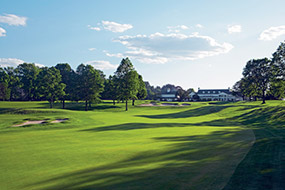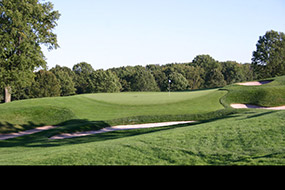One of the surprise packets of northern New Jersey, the Plainfield County Club was established in 1890 but today golf’s on a restored Donald Ross masterpiece that dates back to 1921. Built atop the lush, rolling slopes of Edison, the Ross layout is noted for its ferociously contoured greens and a brilliant routing that makes perfect use of both the natural pitch and fall of the land as well as a large, principal ridge that cuts across the site.
Despite its obvious quality, the present course has endured much change over the years, starting with a club decision in the 1930s to abandon its 17th and 18th holes in favor of a driving range. Ross helped accommodate the range by reshuffling his holes, converting two into the terrific par five 12th and then designing three new holes on additional land the club had acquired. These new holes were reshaped by Geoffrey Cornish during the 1960s and also changed when a natural stream was replaced by a couple of ponds. Built on the flattest part of the property, and without the direct supervision of Donald Ross, they were unlikely to have ever been highlights here but are now quite disappointing when compared with the rest of the layout.
The main site, by contrast, has lots of interesting undulation, the fairways traversing great sweeping ridges and the greens attractively set among natural depressions or atop bold crests. Aside from the three flat holes, the strength of the course is the absence of dreary ground or moderate design. The opening stretch is quite outstanding, starting with a couple of strong par fours routed across left-leaning fairways. The 1st features a remarkably severe target whose back right portion is several feet higher than the front left, while the 2nd boasts a thrilling approach shot across a bunkered valley and into crested green cut into the side of a mound. The strong, dipping par four 7th is another tremendous hole, this time its approach is played from a falling fairway over a deep cross-bunker and into a semi-sunken green.
The golf around the turn is equally outstanding. The heavily tilted 9th green and skinny half-pipe 10th are both terrific conclusions to quality mid-length par fours, while the 11th is a beautiful short par three played across a valley and into a small, steep green saddled atop a ridge. Also wonderful is the par five 12th, which is complicated by a tight driving zone and a drainage ditch that splits the final third of its fairway and then wraps around the left side of its target. The 16th is another intriguing par five, its fairway cut by an enormous bunker complex and its vast putting surface flowing beautifully back-to-front from beneath the 17th tee. Ending the round are a couple of fine doglegging two-shotters, the 17th turning sharply to the right and heading uphill and the final hole bending the other way but also rising into a lovely crowned green site.
Like many courses of this vintage, Plainfield had suffered badly as a result of over-planting, but the layout has been transformed by a major restoration program undertaken by architect Gil Hanse. Starting in 2000, Hanse worked on returning greens and fairways to their original specifications and removed hundreds of trees to open up vistas and improve turf conditions. Now more successfully preserved, the course is still relatively unheralded but it comes highly recommended for all fans of classic golf design.

 this course also has exceptional:
this course also has exceptional:

